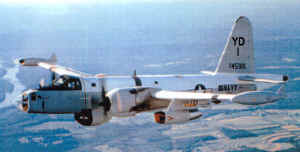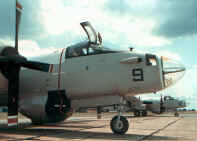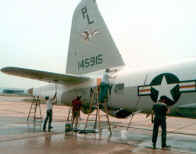|
The Lockheed P-2V (SP2-H) Neptune
(click on portions of the photo below for details)
 The Lockheed P2V "Neptune" is unique in that it is the only American
naval land-based patrol plane ever designed expressly for this purpose. Both the Neptune's
predecessor, the PV2 "Harpoon", and successor, the P3 "Orion", were
first built by Lockheed as transports... the PV2 as the "Lodestar", and the P3
as the "Electra". The P2V was also the last US military aircraft to feature the
Emerson ball turret, which was installed for a time in the aircraft nose, and was the last
radial engine powered bomber accepted for delivery by the US. From May 12, 1945 to the end
of its production run in 1962, 1,036 Neptune's were produced in seven major variants, with
the US Navy receiving the vast majority. The Neptune's versatility is evident from the
many missions this aircraft was called on to perform... it truly set the standard for
modern patrol aircraft. The Lockheed P2V "Neptune" is unique in that it is the only American
naval land-based patrol plane ever designed expressly for this purpose. Both the Neptune's
predecessor, the PV2 "Harpoon", and successor, the P3 "Orion", were
first built by Lockheed as transports... the PV2 as the "Lodestar", and the P3
as the "Electra". The P2V was also the last US military aircraft to feature the
Emerson ball turret, which was installed for a time in the aircraft nose, and was the last
radial engine powered bomber accepted for delivery by the US. From May 12, 1945 to the end
of its production run in 1962, 1,036 Neptune's were produced in seven major variants, with
the US Navy receiving the vast majority. The Neptune's versatility is evident from the
many missions this aircraft was called on to perform... it truly set the standard for
modern patrol aircraft.
In early 1941, Lockheed Aircraft's Vega
division began design work on a twin-engine bomber. It was felt that the aircraft,
utilizing the then new Wright R-3350 Cyclone engine, would be able to carry a larger bomb
load for longer distances than existing four engine heavy bombers like the B-17
"Flying Fortress" and B-24 "Liberator". The resulting aircraft design,
designated "model 26", was a large, mid-wing bomber, accommodating a crew of
seven. Because it was a relatively low wartime priority, (at the time even longer range
and heavier bomb loads were being planned for), the "model 26" project's R-3350
engines were diverted to another project, the Boeing B-29 "Superfortress".
Development of the "model 26" prototype was renewed as the war progressed,
however, with fifteen aircraft ordered by the Navy in April of 1944. The XP2V-1
"Neptune", as it was designated, was finally flown for the first time toward the
end of the war on May 17, 1945, shortly after the German surrender.
As with many of the aircraft with a relatively long
production run, the original P2 design saw a great many changes from model to model.
Successive "Neptune" models gradually removed armament in favor of more
anti-submarine electronics, but all models kept the large weapons bay included in the
design of the first "Neptune" model, the P2V-1. In additional armament, the
P2V-1 carried three pairs of 12.7 mm machine guns and mountings for up to sixteen underwing rockets.
The P2V-2 model added up to eight 20mm cannons in the
nose, tail, and dorsal position. The P2V-3 began the trend of eliminating armament in
place of more electronics, by adding APS-20
radar and the characteristic belly radome. The P2V-4 included the turbo-compound
engine and auxiliary wingtip fuel tanks. Increasing
weight (Including the addition of Jezebel underwater detection equipment) caused many of
the P2V-5 models to include the retrofit of Westinghouse J 34 jets to improve takeoff, and
to add maneuvering speed during combat. (This model was designated the P2V-5F). The
addition of the MAD stinger, first on the P2V-5, and the deletion of guns and the top
turret, as the subs went nuclear, brought the Neptune to its final major configuration,
the P2V-7, which was flown first on April 26, 1954. This last model was to remain in
service for more than 20 years. P2V "Neptunes" were operated by the US Navy,
Army and Air Force, as well as Argentina, Australia, Brazil, France, the Netherlands,
Portugal, and the United Kingdom. In addition, the Japanese defense force utilized the
design, produced under license by Kawasaki, with turboprop powerplants.
Assuming its patrol duties with the US Navy shortly
after the Second World War, Neptunes saw their first combat use during the Korean
Conflict. There they were used in ground attack, mine laying, day and night bombing and
rocket attack and as armored combat transports as well. They became the "Cold
War" patrol aircraft along both American coasts, were active in the Cuban missile
crisis, and participated in the American space program as well. During the Viet Nam war
P2's were involved with electronic warfare and, as night and all-weather interdiction
aircraft. (The Army's OP-2E version dropped sensors along the Ho Chi Minh trail and other
supply routes to detect enemy troop and vehicle movement.)
 The most famous "Neptune" was, without a doubt, a P2V-1, the
"Truculent Turtle", which, from September 29th through October 1st, 1947, flew
non-stop, without refueling, from Perth, Australia, to Columbus, Ohio, a world-record
setting distance of 11,235 miles. This piston engine powered record stood almost forty
years, until Burt Rutan's "Voyager" circled the globe non-stop in December of
1986. A more typical "Neptune" mission lasted ten hours, with a crew of ten.
Because of the long mission capabilities, the P2's were equipped with a small galley and
an electric stove. The only bunk, however, was soon removed to make way for additional
electronics gear, with the floor or wing being the only place to stretch out. The most famous "Neptune" was, without a doubt, a P2V-1, the
"Truculent Turtle", which, from September 29th through October 1st, 1947, flew
non-stop, without refueling, from Perth, Australia, to Columbus, Ohio, a world-record
setting distance of 11,235 miles. This piston engine powered record stood almost forty
years, until Burt Rutan's "Voyager" circled the globe non-stop in December of
1986. A more typical "Neptune" mission lasted ten hours, with a crew of ten.
Because of the long mission capabilities, the P2's were equipped with a small galley and
an electric stove. The only bunk, however, was soon removed to make way for additional
electronics gear, with the floor or wing being the only place to stretch out.
The P2V-7 model, the type acquired and now operated
by the Mid Atlantic Air Museum, was first flown in 1954. Redesignated SP-2H, OP-2E, and
AP-2H after 1962, "Neptune"s continued to serve through the Viet Nam war and
until the mid 1970's. By that time, however, the P3 "Orion" had replaced the P2
in all service but with reserve units. Most found their way to Davis Monthan Air Force
Base, in Arizona, where they were placed in storage.
Despite the Neptune's long service history, and
significant role in aviation and in our nation's defense, very few of these unique
aircraft have been preserved in museums. The Naval Museum in Pensacola does have on
display both the "Truculent Turtle" and a P2V-7 model as well. A P2V-5 is on the
deck of the Intrepid Air and Space Museum in New York, and an AP2H exists on display at
the Pima Air Museum in Tucson. A few more remain as gate guardians at Naval Air Stations,
including NAS Brunswick, and NAS Jacksonville.
Operational Neptunes are even more difficult to find.
Several have found service as fire bombers in the western United States. At this time,
restored operating examples can also be found in the Netherlands and in Australia. In the
United States, a few other P2V-7's have been operated for a time by museums, but not
consistently. The Mid Atlantic Air Museum, of Reading, Pennsylvania, has operated its
P2V-7, flying to airshows to display the aircraft, for more than ten years. The aircraft
is an "ongoing restoration", each year becoming more authentic with the addition
of new equipment.
 The Mid Atlantic Air Museum acquired two P2V's through the Federal Surplus
Property program during the fall of 1983. BU NO 145915 filled the following assignments
during its time with the US Navy: VP 21 and VP-23, NAS Brunswick, VP-92 NAS South
Weymouth, VP-94 NAS New Orleans, VP-56 NAS Norfolk, and VP-67 NAS Memphis. It served
actively during the Cuban missile crisis in 1962, with VP-23. The Mid Atlantic Air Museum acquired two P2V's through the Federal Surplus
Property program during the fall of 1983. BU NO 145915 filled the following assignments
during its time with the US Navy: VP 21 and VP-23, NAS Brunswick, VP-92 NAS South
Weymouth, VP-94 NAS New Orleans, VP-56 NAS Norfolk, and VP-67 NAS Memphis. It served
actively during the Cuban missile crisis in 1962, with VP-23.
In storage for several years at Davis Monthan Air
Force Base, covered with preservatives and desert dust, the Museum's Neptune was a dismal
sight as it greeted a work party of Museum volunteers. Over a week's time they removed
animal nests, installed instruments and avionics, and made the aircraft flight-worthy. A
two day return trip to the Museum's home in Pennsylvania was achieved without incident.
(The crew chose not to use the heaters in the aircraft, in order to not risk problems,
which made for an extremely cold wintertime return trip!) Museum volunteers set to work
immediately cleaning up the aircraft and beginning the restoration process. 
As a "flying" museum, part of the mission
of the Mid Atlantic Air Museum is not only to restore, but also operate classic aircraft
like the P2V. The Neptune travels to five or six airshows each year, where it performs
fly-bys for the crowd and is also opened for tours to the general public. Thousands of
people each year have the experience of touring the P2 from the bow observer station to
the MAD stinger. Most air show visitors have little knowledge about the aircraft and its
mission. Museum volunteers "man" many of the crew positions, helping to explain
the functions of the crew members and use of the equipment on board. They share the
history of the aircraft that, for many years, was the major airborne defense system for
the US coasts. Visitors are always amazed at the lack of creature comforts and cramped
space, are impressed with the galley, and enjoy climbing over the wing as a part of their
tour. Museum volunteers have also benefited from the tours, learning a great deal about
the Neptune from those who flew aboard them.
From the time the aircraft flew to its first airshow,
ex-Neptune crewmen have been drawn to the aircraft. They climb aboard to reminisce, to
show family members the aircraft that they spent so much time serving aboard. Reserve
squadrons have provided much of the now outdated electronics equipment which has been
installed on the aircraft, and, as well, provided uniforms, manuals, and photographs for
the museum collection. Just as fascinating have been the hundreds of stories collected
from ex-P2 crewmen concerning their eventful and not-so-eventful missions. Everything from
combat experiences and engine out performance to pranks played on new crew members has
been recounted.
SPECIFICATIONS
Engines:
Two Curtis-Wright R-3350-32WA
(3750 HP)
Two Westinghouse J-34-WE-36
turbojets (3400 Lbs. static thrust)
Wing Span:
103 Feet, 10 Inches
Length:
91 Feet, 8 Inches
Maximum Speed:
364 MPH
Range:
4,350 Miles
Armament:
Up to 12,000 Lbs. of bombs, torpedoes, depth charges, mines, or rockets.
Please support the VP-4 Association by visiting
our sponsors.
|